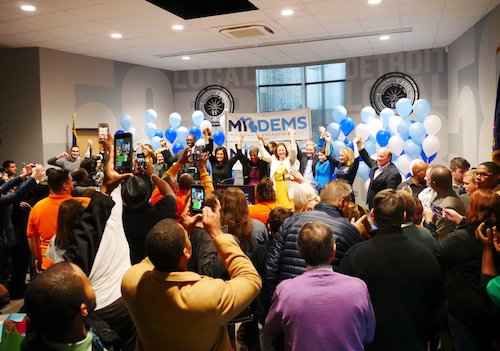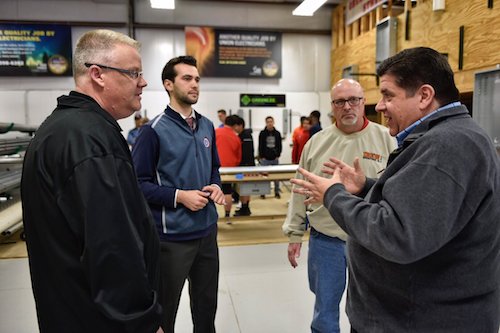A little less than a year ago, the Electrical Worker told you about a crisis in our democracy. The picture was dark. Tens of millions of American citizens live in gerrymandered electoral districts with borders surgically created to keep incumbent politicians in office. Millions more voters are locked out of the voting booth entirely.

|
|
Then-candidate Gretchen Whitmer held a rally at Detroit Local 58 during her 2018 campaign. The new governor has pledged to stand up to the same anti-union legislators who rammed through a right-to-work law in 2013.
|
Nevertheless, in the 2018 midterm election, hundreds of politicians at all levels of government were tossed out of office — many in districts purposely drawn to prevent just that. The stakes were enormous.
New legislative maps will be drawn in 2021 after the next census, but if there was to be any hope that working people wouldn't lose another decade to the banks and the bosses, single party control in states had to be smashed.
The nation's democratic future is much brighter today than it was before Election Day. In addition to all the new faces, nearly a dozen states passed ballot initiatives that throw open voting booths to millions of disenfranchised citizens and take the mapmaking tools out of the hands of party hacks.
But the details matter, and when examined closely, some of the clouds retained their dark linings.
For example, 40 congressional seats flipped red to blue, delivering an activist caucus of progressive, pro-union representatives to offices that had been filled with corporate sympathizers seemingly hand-picked by Wall Street executives.
But of the new faces, less than a quarter won in districts drawn by elected officials. More than 75 percent were in districts drawn by nonpartisan commissions or courts after legal challenges.
"We still live in a country where a politician has a better chance of choosing their pool of voters than the other way around," said International President Lonnie R. Stephenson.
More than half of states are still under the unitary control of a single party. It is true that Republicans have been much more aggressively anti-union, but when only one party is in charge, neither party does especially well for organized labor or working people.
"The headlines in Congress were welcome news, but below that we see a tremendously mixed bag," said Political and Legislative Director Austin Keyser. "Life gets better for working people when politicians of both parties have to compete for our allegiance. You'd be hard pressed to look around and see that yet."
First, the Bad News
At least 23 states passed new voter restrictions since the 2016 election, and hundreds of polling places have been closed since 2013, mostly in the right-to-work South.
Millions of voters were purged from voting rolls: Florida purged 7 percent of all eligible voters, Georgia more than 10 percent and North Carolina more than 12 percent, according to a 2016 report from the Leadership Conference Education Fund.
The result, Keyser said, were states where voters went one direction, but you'd never know it by who showed up in statehouses in January.
In North Carolina, for example, Democrats won nearly 50 percent of all votes cast, but Republicans won 10 of 13 U.S. House seats. In Ohio, Republicans won only 52 percent of all votes but took 12 of 16 House elections and 73 of 116 statehouse races.
It was even starker in Wisconsin. Despite Democrats winning every statewide office on the ballot and receiving 200,000 more total votes, only one Republican incumbent lost his seat in Wisconsin's lower house. Democrats netted 1.3 million votes for the Assembly, 54 percent statewide, but Republicans returned to the Capitol in 2019 holding 63 of 99 seats in the legislative body.
"Since they redrew the maps a decade ago, they've done everything they could think of to shut us up," Stephenson said. "We did a darn good job of making ourselves heard all the same, but the job isn't close to done."
The Good News
One of the most positive signs was that more people ran this time. Safe politicians, no matter their party, rarely listen to working people. This doesn't have to be true, but politicians on the right with no challenger settle comfortably into the silk-lined pockets of the Chamber of Commerce, and Democrats end up talking about everything but decent jobs.
More than 6,000 seats were up in 2018 in 87 of the 99 state legislative bodies. At least 30 governors, lieutenant governors and attorneys general were up along with 27 secretaries of state.
In every state, at every level, more incumbents faced an opponent.
In Texas, 14 of 15 state Senate seats and 133 of 150 state House seats were contested, a near 50 percent increase since the last midterm election.
In Pennsylvania, Democrats ran in 180 of 203 state legislative districts, the most in almost two decades.
Before the 2018 election, Republicans controlled both legislative chambers and the governorship in 26 states — a scenario known as a trifecta. Democrats similarly controlled eight states.
After the election Republicans lost four trifectas — Kansas, Michigan, Wisconsin and New Hampshire — and gained only Alaska in return.
Democrats also broke Republican supermajorities in North Carolina, Michigan and Pennsylvania.
Voters broke one-party GOP control of state executive offices (governor, secretary of state and attorney general) in four states — sometimes called a triplex — winning secretary of state offices in Colorado, Michigan and Arizona and attorneys general in Colorado, Michigan and Nevada.
"This gives me hope that for the first time in close to a decade — especially in the key swing states in the upper Midwest — voters will be heard, and we can start reversing some of the catastrophic decisions made by now-former governors like Scott Walker and Bruce Rauner," Keyser said.
Ballot Measures and the Courts
Still, sometimes voters have to take matters into their own hands and claw back the power from representatives by directly putting the question to the people.

|
|
New Illinois Gov. Jay Pritzker visited union halls across the state during the 2018 campaign, including this stop at Rockford Local 364. New governors could be a critical backstop to further efforts to dilute working families' votes.
|
From 2010 to 2017, there were only five measures that expanded access to the ballot, reported the Brennan Center for Justice, a non partisan public policy institute based at the New York University Law School.
In the 2018 election alone, 10 ballot-expansion measures passed. Ohio, Michigan, Missouri, Utah and Colorado all reformed their redistricting laws, taking some or all power from elected officials and injecting some sunlight into the democratic process.
A new voter-approved redistricting commission in Michigan will take map-drawing power away from elected officials and put it in the hands of a bipartisan commission, and in Florida, voters overwhelmingly approved a constitutional amendment to restore voting rights to many nonviolent felons upon completion of their sentences.
In one final bit of potentially good news, just one day after the new Democratic majority took over in the House, the Supreme Court agreed to hear two cases challenging particularly egregious gerrymandering in Maryland and North Carolina. For the first time, the Supreme Court could rule that a partisan gerrymander is so skewed that it violates the Constitution.
Or it might not.
"It's hard to put a great deal of hope in a court that is this conservative, but I think Chief Justice John Roberts is eager to show that the Supreme Court can rise above this darkly partisan time," Keyser said. "But even if they rule against us this time, that won't change the truth that people are taking gerrymandering seriously in a way they weren't 10 years ago."
"We're grateful to all our union brothers and sisters who have taken this issue so seriously," Stephenson said. "In less than two years, we'll have another chance to put representatives in place who will stand up for fairness in elections. The 2018 strides were a great start, and I'm excited to work even harder to level the playing field for the next decade and make sure working families have an equal voice in our democracy."